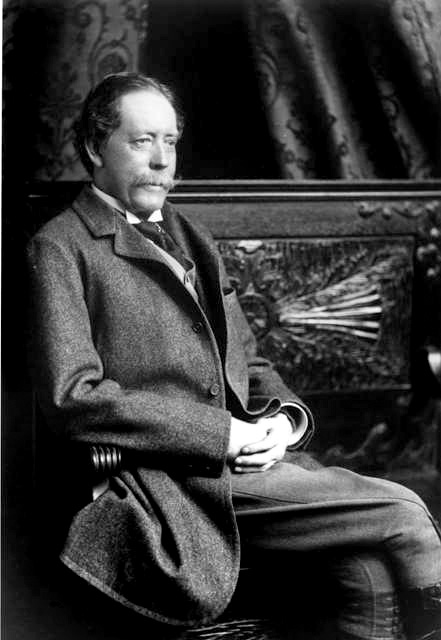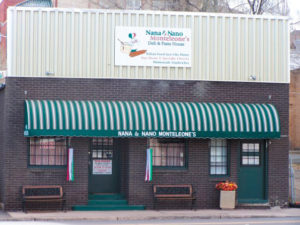By Forrest Whitman
Lots of the railroad history around Central Colorado is fun to discuss and argue about. The great railroad war (1878-1890) was a fierce fight. The contenders were General William Jackson Palmer’s Denver and Rio Grande Railroad versus the Santa Fe Railroad led by William Barstow Strong and Thomas Nickerson. The reader is invited to revisit the sites of the battles.
The first battle: A fine way to look at this site is to take the Southwest Chief passenger rain. As that train crawls up Raton Pass, I recommend getting a beverage and scanning out the sightseer lounge car window. Near the summit there’s still a sign erected by the Santa Fe Railroad. It’s announcing the site of “Uncle Dick Wootton’s place.”
This opening skirmish was fought in the very early morning of February 27, 1878. As the name of his line says, Palmer wanted to build south to the Rio Grande. The Santa Fe coveted the same territory.
The law was on the side of which railroad could lay track in the pass first. This battle should have gone to Palmer. He had interests in southern Colorado for a long time and had built rail here. Why didn’t he claim the pass long before 1878?
On that fated night the chief engineer of the Rio Grande, J.A. McMurtrie, assembled a track crew at El Morro outside of Trinidad. He was ready, at last, to build track and claim Raton Pass (the way to Santa Fe). Only then did Palmer act, but his men missed the big party.

According to some historians (like Phyllis Flanders Dorset) there was quite a party going on at Uncle Dick’s place the night of the 26th. The boozed-up men headed out in the dark to lay some track by lantern light at “three of the most difficult points in the pass.” They knew where to go because a scout for the Santa Fe, William Morley, (disguised as a sheep herder) had walked the whole route.
The next morning the Rio Grande crew arrived too late. There were some shouted threats and a bit of pushing and shoving, but the Santa Fe had won. According to some accounts the Santa Fe had some “muscle” on hand in the form of Bat Masterson and some of the toughs he’d use in the next battle. But were they there or not?
According to other historians, like Walter R. Borneman, Gen. Palmer wasn’t all that sorry to lose the first battle since he was so engrossed in building the La Veta Pass line into Fort Garland and then south.
Debate about what happened at that first battle should keep amateur sleuths busy in the bar car all the way to Raton, New Mexico.
The next battle requires another train trip, this time on the Royal Gorge Scenic Railroad. As you look up at those canyon walls and see the rushing water below you’ll get an idea of how tough it was for the Santa Fe crews to build through there in 1878. They had a legal right to twenty miles of track but it was tough.
Both the Santa Fe and the D&RG wanted to get to the riches of Leadville and that meant building upstream on the Arkansas River. This time, General Palmer was ready for the fight. He built forts strategically placed along the river above the gorge. Let the Santa Fe build away in the gorge – they’d never get to Leadville past those forts!
But where were they? As you drive along U.S. Highway 50 you can speculate. One site, at Spike Buck, is easy to see. It was featured in what today we’d call press releases. But at least one historian, Borneman, thinks that fort was a public relations attempt. We railroad sleuths could do better checking around where the rails actually emerge from the canyon at Parkdale.
How bloody were the battles, anyway? We could argue that one. Some accounts of the many fatalities are pretty suspect. One of the “killed,” a Mr. John (or James) Gallagher walked into the newspaper offices of the Pueblo Chieftain when he read of his death. “One of the liveliest corpses we’ve seen for many a day,” quipped a reporter. Just how serious did the shooting war become? Historians vary widely.
The only confirmed fatality was at the Santa Fe roundhouse in Pueblo. To get a feel for how the battle was fought there you can stop at the lovely old passenger station. If you walk the tracks you’ll see many old railroad cars the historical society has stored there. Even though there’s been a big flood since 1879 the topography is likely about the same.
[InContentAdTwo]
The most spectacular battle happened there. The Santa Fe had hired the famous Bat Masterson to defend the station and he’d hired some really bad dudes to help him. They included Dirty Dave Radebough, Mysterious Dave Mather and gunslingers Doc Holliday and Ben Thompson. They had stolen a cannon and were ready to defend the place from the Rio Grande men. Was the cannon on the slope above where today’s levee rises?
The battle was short-lived as the tough guys ran out the back door. The one confirmed fatality was of a Santa Fe employee shot in the back as he climbed out the window. We can argue about that too. Maybe the Santa Fe was pulling out of the war. They probably saw the courts leaning toward Palmer’s side. The big game for them, perhaps, was unimpeded trackage south to Santa Fe and on to the West Coast.
By April of 1879 the war was over, ended by the treaty of Boston. The Rio Grande could build to Leadville, but go no further south than Española, New Mexico. The Santa Fe was then on its way unhindered to California.
Here’s hoping a letter to the editor will tell us what our amateur sleuths decide.



